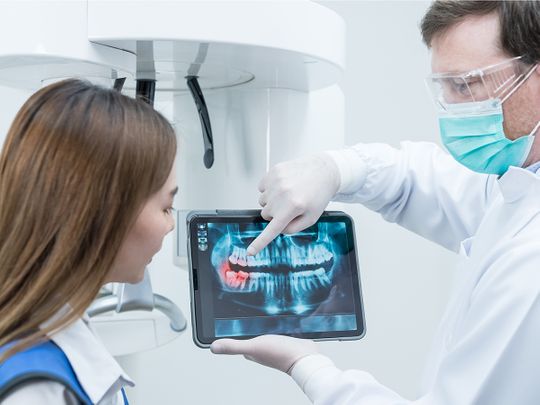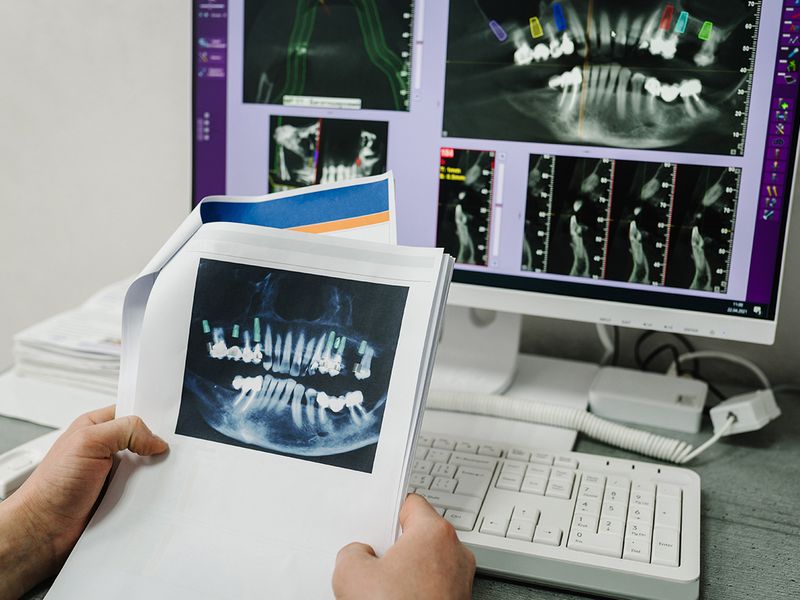
Are you overdue for a dental check-up, perhaps driven in by a nagging toothache, other dental concerns, or even a touch of guilt? Brace yourself, not for a scolding from your dentist, but for the exciting world of cutting-edge options that can keep your teeth healthy and radiant.
High-tech x-rays
Within many dental clinics, the era of digitised x-rays is steadily replacing traditional radiographs. Although digital x-rays have graced the market for several years, their recent surge in popularity among dentists can be attributed to their enhanced efficiency and reduced radiation exposure.
Dr Rabih Abi Nader, Implantologist and Oral Surgeon, and Medical Director at Sky Clinic Dental Center, underscores the advantages of digital x-rays over traditional radiographs. “Digital x-rays provide instant images without the need for chemical processing, and they can be easily manipulated for enhanced diagnostics. Dentists can zoom in, adjust contrast, and compare images over time, resulting in more precise diagnoses and refined treatment plans,” he explains.
Dr Renju Prem, Specialist Oral and Maxillofacial Surgeon at Aster Hospital in Mankhool, emphasises the substantial reduction in radiation exposure for patients when compared to traditional film-based radiographs. He says, “This reduction aligns with our unwavering commitment to patient safety.”
Dr Imneet Madan, a Laser Specialist Paediatric Dentist in Dubai, highlights the importance of minimising diagnostic exposures, given the background radiations we encounter daily. She elaborates, “A single bitewing x-ray, the standard scan to check for cavities between back teeth, exposes individuals to about 0.001mSv of radiation. To put this in perspective, a 3.5-hour plane ride exposes an individual to 0.01mSv, which is 10 times the amount of a bitewing x-ray. A standard medical chest x-ray is 0.1mSv, or 100 times the exposure of a bitewing x-ray, and a chest CT scan is 7mSv, or 7,000 times the exposure.”
Additionally, storing digital images electronically eliminates the need for physical storage space, mitigates the risk of damage or loss, and streamlines the process of retrieving patient records. Dr Prem adds, “Digital x-rays contribute to environmental sustainability by eliminating the need for hazardous chemical processing, aligning with our commitment to a greener future.”

Laser tooth cavity detection
In the realm of dentistry, many practitioners are now making the transition to diode lasers, a sophisticated tool for detecting tooth decay. This technology offers dentists the option to monitor tooth conditions over time or recommend cavity removal and filling.
Dr Nader elaborates on the mechanics of diode lasers, stating, “These lasers emit a wavelength that is absorbed by decayed tooth structure, causing it to fluoresce. The laser detects this fluorescence, enabling early identification of cavities, even before they become visible on x-rays or to the naked eye. This empowers dentists to intervene sooner, preserving more of the natural tooth structure.”
Dr Prem simplifies the concept, explaining that diode lasers emit a specific wavelength of light that penetrates tooth enamel. When this laser interacts with a cavity or weakened area, it reflects differently, enabling precise detection of incipient cavities that may elude traditional methods. He notes, “Besides, diode lasers are non-invasive and painless, sparing patients from uncomfortable probing during cavity detection.”
For cavity detection, diode lasers employ transillumination, measuring tooth density. As the dentist directs light at teeth, some of it penetrates while some reflects back to a sensor. Dr Madan illustrates, “Healthy teeth appear translucent, absorbing all the light, while lesions and decayed areas look cloudy or opaque, hindering light passage. The amount of reflection from decay registers as a numerical reading on the diode laser machine, with a higher number indicating more severe decay.”
CAD/CAM technology
The fusion of computer-assisted design (CAD) and computer-assisted manufacture (CAM) technology has ushered in a new era of efficiency in dental procedures, particularly in the area of crown and bridge fabrication. This technological marvel translates into fewer dental visits, significantly reducing chair time.
Dr Nader describes the process, “CAD/CAM technology entails digital impressions and computer-guided design, enabling precise and custom-fit restorations. It streamlines the procedure, eliminating messy impressions and reducing the time patients spend in the chair. The result is durable, aesthetically pleasing restorations that closely mimic natural teeth.”
Dr Prem highlights the efficiency and precision CAD technology brings to digital impressions, eliminating the discomfort associated with traditional moulds. CAM technology seamlessly transforms digital designs into physical restorations, minimising the chances of human error and ensuring consistently high-quality outcomes. He remarks, “The accuracy of CAD/CAM technology minimises the need for adjustments and remakes, reducing patient discomfort and enhancing overall satisfaction. By harnessing these advanced technologies, we strive to offer our patients the highest standard of care, characterised by efficiency, precision, and patient-centricity.”
Other innovations in dentistry
Beyond the scope of high-tech x-rays and laser technology, remarkable advancements have emerged in dental materials, enhancing options for veneers, bonding, and fillings. Dr Nader says, “Composite materials for veneers and bonding now offer exceptional aesthetics and durability. Dental implants, too, continue to evolve, with improvements in materials and techniques ensuring long-lasting and stable tooth replacements. These innovations enhance both the appearance and function of dental restorations.”
Dr. Thomas Varghese, Specialist Prosthodontics and Implantology, Aster Beauty Clinic, Al Warqa, says veneers now also offer minimal preparation of tooth and patients can get very thin veneers simulating natural tooth mostly made from Emax and feldspathic ceramics.
"As far as dental implants are concerned, modern advancements enable extraction of damaged tooth and immediate placement of implant, besides full mouth implants with immediate replacement of bridge on the same day," says Dr Varghese.
Furthermore, novel treatments for gum disease emphasise minimally invasive approaches and improved healing. Laser therapy and regenerative procedures target and eliminate bacteria while promoting tissue regeneration. Dr Nader concludes, “Advancements in medication delivery systems also offer more effective and targeted treatments, ultimately improving gum health and overall dental well-being.”












